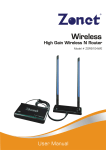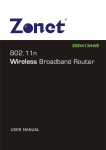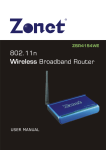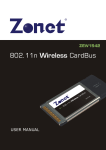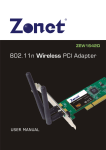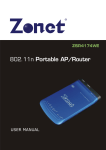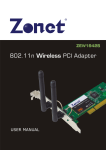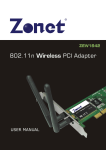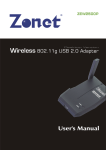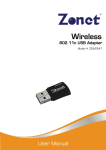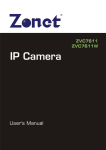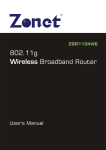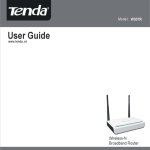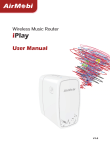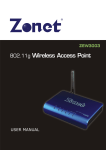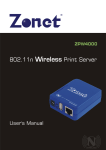Download Zonet ZSR4134WS router
Transcript
Copyright Statement is the registered trademark of Zonet Technology Inc. All the products and product names mentioned herein are the trademarks or registered trademarks of their respective holders. Copyright of the whole product as integration, including its accessories and software, belongs to Zonet Technology Inc. Without the permission of Zonet Technology Inc., any individual or party is not allowed to copy, plagiarize, imitate or translate it into other languages. Table of Contents Chapter 1 Introduction......................................................................... Welcome .............................................................................................. Contents of Package .............................................................................. System Requirement ............................................................................. Getting to Know Your ZSR4134WS .......................................................... 1 1 1 1 2 Chapter 2 Hardware Installation......................................................... 4 Chapter 3 Connect Your ZSR4134WS ................................................... 6 How to Check the Network Connection..................................................... 9 Chapter 4 Basic Configurations ...........................................................10 How to Access the Web-based Configuration Utility ..................................10 Setup Wizard.......................................................................................11 Chapter 5 Advanced Settings ..............................................................15 LAN Settings .......................................................................................15 WAN Settings ......................................................................................16 MAC Address Clone ..............................................................................20 DNS Settings .....................................................................................20 Chapter 6 Wireless Settings ................................................................21 Basic Settings......................................................................................21 Wireless Security Settings .....................................................................23 Advanced Wireless Settings ...................................................................27 WPS Settings.......................................................................................28 WDS Settings ......................................................................................29 Wireless Access Control ........................................................................30 Wireless Connection Status ...................................................................31 Chapter 7 DHCP Server .......................................................................32 DHCP Server .......................................................................................32 DHCP Server List & Binding ...................................................................33 Chapter 8 Virtual Server......................................................................34 Port Range Forwarding..........................................................................34 DMZ Settings.......................................................................................35 UPnP Settings ......................................................................................35 Chapter 9 Traffic Control ...................................................................36 Chapter 10 Security Settings...............................................................37 Client Filter .........................................................................................37 URL Filter ............................................................................................38 MAC Filter ...........................................................................................39 Prevent Network Attack ........................................................................39 Remote WEB Management ....................................................................40 Wan Ping ............................................................................................40 Chapter 11 Routing Settings ...............................................................41 Routing Table .....................................................................................41 Chapter 12 System Tools.....................................................................42 Time Settings ......................................................................................42 DDNS .................................................................................................42 Backup/Restore ...................................................................................43 Upgrade..............................................................................................43 Restore to Factory Default Settings ........................................................44 Reboot................................................................................................44 Change Password .................................................................................45 System Log .........................................................................................45 Appendix 1 Product Features & Specifications ..................................46 Appendix 2 Troubleshooting...............................................................48 Chapter 1 Introduction Welcome Thank you for purchasing Zonet ZSR4134WS – 802.11n wireless broadband router! This high cost-efficiency router is the best choice for Small office / Home office users, all computers and network devices can share a single xDSL / cable modem internet connection at high speed. Easy install procedures allows any computer users to setup a network environment in very short time - within minutes, even inexperienced. When the number of your computers and network-enabled devices grow, you can also expand the number of network slot by simple attach a hub or switch, to extend the scope of your network! All computers and IEEE 802.11b/g/n wireless-enabled network devices (including PDA, cellular phone, game console, and more!) can connect to ZSR4134WS without additional cabling. The MIMO technology also gives you the highest speed of wireless experience ever! With a compatible wireless card installed in your PC, you can transfer file for up to 300Mbps! The radio coverage is also doubled, so don’t worry if your office or house is really big! Moreover, the user-friendly Setup Wizard on the installation CD can assist you to set up ZSR4134WS easily. It also can be managed or configured through Local/Remote easy-to-use Web-based utility. Contents of Package One One One One One One ZSR4134WS CD w/User Manual Quick Installation Guide(English) Quick Installation Guide(Spanish) Cradle Power Adapter Contact your local authorized reseller or the store purchased from for any items damaged and/or missing. System Requirements Internet connection, provided by xDSL or cable modem with a RJ-45 Ethernet port. Computer or network devices with wired or wireless network interface card. Web browser (Microsoft Internet Explorer 6.0 or above, Firefox 2.0 or above). An available power socket (100–240V, 50/60Hz) 1 Getting to Know Your ZSR4134WS Top Panel LED Indicator Status Description POWER ON ZSR4134WS is switched on and correctly powered SYS Flashing Indicates the system works normally. ON Indicates WAN port is connected Flashing Indicates WAN activity (transferring or receiving data) Flashing Indicates the wireless signal is OK. ON Indicates LAN port is connected Flashing Indicates LAN activity (transferring or receiving data) Flashing Indicates ZSR4134WS is negotiating with WPS clients in WPS Mode (PBC or PIN). WAN WLAN LAN(1/2/3/4) WPS 2 Rear Panel Item Name Description Antenna These antennas are 3dBi dipole antennas. POWER Power connector, connects to power adapter WAN Wide Area Network (WAN / Internet) port. 1-4 (LAN Ports) Local Area Network (LAN) ports 1 to 4 RESET/WPS Reset ZSR4134WS to factory default settings (clear all settings) or start WPS function. Press this button and hold for 7 seconds to restore all settings to factory defaults, and press this button for 1 second to start WPS function. 3 Chapter 2 Hardware Installation Please follow the following instruction to build the network connection between your ZSR4134WS and your computers, network devices: 1. Connect all your computers, network devices (network-enabled consumer devices other than computers, like game console, or switch / hub) to the LAN port of ZSR4134WS. 2. Connect the power adapter to the wall socket, and then connect it to the “Power” socket of ZSR4134WS. 4 3. Connect your xDSL / cable modem to the WAN port of ZSR4134WS by Ethernet cable. 4. Please check all LEDs on the top panel. POWER LED should be steadily on, WAN and LAN LEDs should be on if the computer / network device connected to the respective port of ZSR4134WS is powered on and correctly connected. If any LED you expected is not on, please recheck the cabling, or jump to “Troubleshooting” for possible reasons and solution. 5 Chapter 3 Connect Your ZSR4134WS How to Set the Network Configurations for My Computer 1. Click Start → Control Panel 2. Click Network and Internet Connections → Network Connections 6 3. Right click Local Area Network Connection and select Properties. 4. Select Internet Protocol (TCP/IP) and click Properties. 7 5. Select Obtain an IP address automatically and Obtain DNS server address automatically. Click OK to save the configurations. 8 How to Check the Network Connection 1. Select Start → Programs → Accessories → Command Prompt. 2. Input ping 192.168.0.1 and press Enter. If the screen displays as below, it means your PC is connected to your router successfully. If not, please make sure the hardware installation and network adapter are OK. 9 Chapter 4 Basic Configurations This section is to show you how to configure your new ZSR4134WS through the Web-based Configuration Utility. How to Access the Web-based Configuration Utility 1. After your computer obtained an IP address from ZSR4134WS, please start your web browser, and input the default IP address of ZSR4134WS http://192.168.0.1 in address bar. 2. Please input user name and password and then click OK. Both default user name and password is admin. 10 Setup Wizard 1. When Welcome to Setup Wizard pop out, Click Next to continue. 2. Select one Internet connection type you’re using. If you’re not sure, click Detect or contact your Internet Service Provider. Click Next. 11 a. ADSL Virtual Dial-up (Via PPPoE) Enter the Account and Password provided by your ISP, and click Next. b. Dynamic IP (Via DHCP) If your connection type is Dynamic IP, it means your IP address keeps changing every time you connect. You do not need to enter the information. c. Static IP Fill the network address information from your ISP in the IP Address, Subnet Mask, Gateway and Primary DNS server fields and click Next. d. L2TP Enter the Account and Password provided by your ISP. L2TP(Layer 2 Tunneling Protocol) provides two address modes. Dynamic IP: If the L2TP offered by your ISP is Dynamic IP, please select Dynamic IP. Static IP: Please fill in the parameters provided by your ISP. 12 After configuration, please click Next. e. PPTP Enter the Server IP Address, User Name, and Password provided by your ISP PPTP(PP Tunneling Protocol) provides two address modes. Dynamic IP: If the PPTP offered by your ISP is Dynamic IP, please select Dynamic IP. Static IP: Please fill in the parameters provided by your ISP. After configuration, please click Next. 13 3. Click Apply and reboot ZSR4134WS, or select Reboot in System Tools of the left menu and click Reboot the router button. 4. While rebooting, please wait for few minutes and DO NOT power off. 5. Select System Status of the left menu to find out the current network and system information. 14 Chapter 5 Advanced Settings LAN Settings MAC Address: ZSR4134WS’s physical MAC address on your local network is unchangeable. IP Address: ZSR4134WS’s LAN IP address (not your PC’s IP address). Once you modify the IP address, you need to remember it for the Web-based Utility login next time. Default value is 192.168.0.1 Subnet Mask: ZSR4134WS’s subnet mask for measurement of the network size. Default value is 255.255.255.0. 15 WAN Settings a. PPPoE Connection Mode: Show your current connection mode. Account: Provided by your ISP. Password: Provided by your ISP. MTU: Maximum Transmission Unit. It is the size of largest datagram that can be sent over a network. The default value is 1460. Do NOT modify it unless necessary. Service Name: It is defined as a set of characteristics that are applied to a PPPoE connection. Enter it if provided. Do NOT modify it unless necessary. AC Name: Enter it if provided. Do NOT modify it unless necessary. Internet Connection Option: Connect Automatically: Connect automatically to the Internet after rebooting system or connection failure. Connect Manually: Connect to the Internet by the user manually. Connect on Demand: Re-establish your connection to the Internet after the specific time (Max Idle Time). Zero means your Internet connection at all time. Otherwise, enter the minutes to be elapsed before you want to disconnect the Internet access. Connect on Fixed Time: Connect to the Internet during the time you fix. 16 b. Dynamic IP MTU: Maximum Transmission Unit. It is the size of largest datagram that can be sent over a network. The default value is 1500. Do NOT modify it unless necessary. c. Static IP IP Address: Enter the WAN IP address provided by your ISP. Subnet Mask: Enter the WAN Subnet Mask. Gateway: Enter the WAN Gateway. Primary DNS Server: Enter the Primary DNS server provided by your ISP. Secondary DNS Server: Enter the second address if your ISP provides, which is optional. MTU: Maximum Transmission Unit. It is the size of largest datagram that can be sent over a network. The default value is 1500. Do NOT modify it unless necessary. 17 d. L2TP L2TP Server IP: Enter the Server IP provided by your ISP. User Name: Enter L2TP username. Password: Enter L2TP password. MTU: Maximum Transmission Unit, you may need to change it for optimal performance with your specific ISP. 1460 is the default MTU. Address Mode: Select Static if your ISP supplies you with the IP address, subnet mask, and gateway. In most cases, select Dynamic. IP Address: Enter the L2TP IP address supplied by your ISP. Subnet Mask: Enter the Subnet Mask supplied by your ISP. Default Gateway: Enter the Default Gateway supplied by your ISP. 18 e. PPTP PPTP Server IP: Enter the Server IP provided by your ISP. User Name: Enter PPTP username provided by your ISP. Password: Enter PPTP password provided by your ISP. MTU: Maximum Transmission Unit, you may need to change it for optimal performance with your specific ISP. 1478 is the default MTU. Address Mode: Select Static if your ISP supplies you with the IP address, subnet mask, and gateway. In most cases, select Dynamic. IP Address: Enter the PPTP IP address supplied by your ISP. Subnet Mask: Enter the Subnet Mask supplied by your ISP. Default Gateway: Enter the Default Gateway supplied by your ISP. 19 MAC Address Clone MAC Address: The MAC address registered with your Internet service provider. Clone MAC address: Register your PC's MAC address. Restore default MAC address: Restore the default hardware MAC address. DNS Settings DNS: Choose the checkbox to enable the DNS server. Primary DNS Address: Enter the necessary address provided by your ISP. Secondary DNS Address: Enter the second address if your ISP provides, which is optional. 20 Chapter 6 Wireless Settings Basic Settings Network Mode: Supports 802.11b/g mixed, 802.11b, 802.11g and 802.11b/g/n mixed modes. SSID: Main Service Set Identifier. It’s the name of your wireless network. Broadcast (SSID): Decide if ZSR4134WS will broadcast its own ESSID or not. BSSID: It is a 48bit identity used to identify a particular BSS (Basic Service Set) within an area. In Infrastructure BSS networks, the BSSID is the MAC address of the AP Channel: Select the channel used for wireless communication from drop-down list. Available channel numbers are 1 to 13 for European countries, 1 to 11 for USA. 21 Operating Mode: Supports two modes: Mixed Mode: In this mode packets are transmitted with a preamble compatible with the legacy 802.11a/g – the legacy Short Training Field(STF), the legacy Long Training Field(LTF) and the legacy signal field are transmitted so they can be decoded by legacy 802.1a/g devices. The rest of the packet has a new format. In Mixed Mode the receiver shall be able to decode both the Mixed Mode packets and legacy packets. Green Mode: It is an optional mode. In this mode high throughput packets are transmitted without a legacy compatible part. In Green Mode the receiver shall be able to decode both Green Field mode packets, Mixed Mode packets and legacy format packets. Channel Bandwidth: Select the channel bandwidth from 20M or 20/40M to improve the wireless performance. Guard Interval: In telecommunications, guard intervals are used to ensure that distinct transmissions do not interfere with one another. These transmissions may belong to different users (as in TDMA) or to the same user (as in OFDM).The purpose of the guard interval is to introduce immunity to propagation delays, echoes and reflections, to which digital data is normally very sensitive. MCS: To 802.11n, due to the physical rate depends on the modulation, coding rate, the number of spatial streams, a number of factors such as whether the 40MHz binding. These factors will produce a lot of physical rate to be select. For example based on Short GI, 40MHz binding techniques, in four space flow, the physical rate can be up to 600Mbps (i.e. 4 x 150). So, 802.11n proposed the concept of MCS. MCS can be understood as complete combination of the factors that affect the rates, each one labeled with unique integers to identify. For the AP, MCS generally support the range of 0~15. Reverse Direction Grant(RDG): Default value is Enable. Systems and methodologies are described that facilitate increased communication channel bandwidth efficiency in association with scheduled time periods that allocates channel access to particular stations. According to various aspects, systems and methods are described that facilitate providing and/or utilizing reverse direction grants in connection with scheduled channel access. Such systems and/or method can mitigate an amount of unused channel access time after a station completes data transmission prior to an end of the allocated period. Extension Channel: To increase data throughput of wireless network, the extension channel range is used in 11n mode. Aggregation MSDU(A-MSDU): Default value is Disable. Refers to the number of MSDU aggregation through a certain way into a larger load. Here MSDU can be considered as Ethernet packets. Typically, when the AP or wireless client received packet (MSDU) from the protocol stack , it will marked Ethernet header, which we call A-MSDU Subframe; and before sent through the RF port, you need to change to 802.11 packet format. 22 Wireless Security Settings a. Mixed WEP WEP (Wired Equivalent Privacy) is an encryption method used to protect your wireless data communications. WEP uses a combination of 64-bit or 128-bit keys to provide access control to your network and encryption security for every data transmission. Default Key: You can set up to four sets of WEP key, and you can decide which key is being used by default here. WEP Key1, 2, 3, 4: Input WEP key characters here, the number of characters must be the same as the number displayed at “Key Format” field. You can use any alphanumerical characters (0-9, a-z, and A-Z) if you select “ASCII” key format, and if you select “Hex” as key format, you can use characters 0-9, a-f, and A-F. You must enter at least one encryption key here, and if you entered multiple WEP keys, they should not be same with each other. 23 b. WPA-Personal Wi-Fi Protected Access (WPA) is an advanced security standard. It uses TKIP and AES to change the encryption key frequently. WPA Algorithms: Select one encryption type, AES, TKIP or TKIP&AES. Pass Phrase: Enter the key which must have 8-63 ASCII characters. Key Renewal Interval: Specifies the timer the WPA key must changes. The change is done automatically between the server and the client. 24 c. WPA2-Personal The WPA2 is a stronger version of WPA. WPA Algorithms: Select one encryption type, AES, TKIP or TKIP&AES. Pass Phrase: Enter the key which must have 8-63 ASCII characters. Key Renewal Interval: Specifies the timer the WPA key must changes. The change is done automatically between the server and the client. 25 d. Mixed WPA/WPA2-Personal WPA Algorithms: Select one encryption type, AES, TKIP or TKIP&AES. Pass Phrase: Enter the key which must have 8-63 ASCII characters. Key Renewal Interval: Specifies the timer the WPA key must changes. The change is done automatically between the server and the client. 26 Advanced Wireless Settings ZSR4134WS provides some advanced control of wireless parameters, if you want to configure these settings, please click “WLAN Settings” menu on the left of web management interface, then click “Advanced Settings”, and the following message will be displayed on your web browser: BG protection Mode: Auto by default. You can also select On or Off. Basic Data Rates: For different requirement, you can select one of the suitable Basic Data Rates. Default value is (1-2-5.5.-11Mbps). Beacon Interval: Set the beacon interval of wireless radio. Do not modify default value if you don’t know what it is, default value is 100. Fragment Threshold: Set the Fragment threshold of wireless radio. Do not modify default value if you don’t know what it is, default value is 2346. RTS Threshold: Set the RTS threshold of wireless radio. Do not modify default value if you don’t know what it is, default value is 2347. TX Power: You can set the output power of wireless radio. Unless you’re using ZSR4134WS in a really big space, you may not have to set output power to 100%. This will enhance security (malicious / unknown users in distance will not be able to reach your ZSR4134WS). WMM Capable: It will enhance the data transfer performance of multimedia contents when they’re being transferred over wireless network. If you don’t know what it is / not sure if you need it, it’s safe to set this option to ‘Enable’, default value is Enable. APSD Capable: It is used for auto power-saved service. The default is Disabled. 27 WPS Settings Wi-Fi Protected Setup (WPS) is the simplest way to build connection between wireless network clients and ZSR4134WS. You don’t have to select encryption mode and input a long encryption passphrase every time when you need to setup a wireless client, you only have to press a button on wireless client and this wireless router, and the WPS will do the rest for you. WPS Setting: Select it to enable or disable WPS function. The default is Enabled. WPS Mode: Supports two ways to configure WPS settings: PBC) and PIN code. PBC(Push-Button Configuration): If you want to use PBC, you have to push a specific button on the wireless client to start WPS mode, and switch ZSR4134WS to WPS mode too. You can push WPS button of ZSR4134WS, or click PBC button in the web configuration interface to enable WPS Note: Press WPS button of ZSR4134WS for one second and WPS indicator will blinking for 2 minutes. During the blinking time, you can enable another Router to implement the WPS/PBC negotiation between them. At present, the WPS only support one client access. Two minutes later, the WPS indicator will be off. PIN: if you want to use PIN code, you have to know the PIN code of wireless client and switch it to WPS mode, then provide the PIN code of the wireless client you wish to connect to ZSR4134WS. 28 WDS Settings WDS (Wireless Distribution System) is used to expand wireless coverage area. ZSR4134WS provides three modes: Lazy, Bridge and Repeater. WDS Mode: Lazy Mode: You need to configure ZSR4134WS’s BSSID into another device, but don’t need to input another device’s BSSID in ZSR4134WS, and they will connect together automatically. Bridge Mode: You can wirelessly connect two or more wired networks via this mode. In this mode, you need to add the Wireless MAC address of the connecting device into ZSR4134WS's AP MAC address table or select one from the scanning table. At the same time, the connecting device should be in Lazy, Repeater or Bridge mode. 29 Repeater Mode: You can select the mode to extend the distance between the two WLAN devices. Functioning as a WDS repeater, ZSR4134WS connects to both a client card as an AP and to another AP. In typical repeater applications, APs connecting to other APs equipped with WDS functionality must also support WDS. In this mode, you need to add the MAC address of the connecting device into ZSR4134WS's AP MAC address table and the connecting client should be in Lazy, Repeater or client mode. Encrypt Type: You can select from WEP mode, TKIP mode, AES mode for security here. Pass phrase: Enter the key, the key format according to encryption you selected. AP MAC: Input the MAC address of another wireless router. NOTE: Two wireless routers must use the same bandwidth, channel number, and security setting. Apply the settings and reboot ZSR4134WS to activate it. Wireless Access Control This function will help you to prevent unauthorized users from connecting to ZSR4134WS; only those wireless devices who have the MAC address you assigned here can gain access to your ZSR4134WS. You can use this function with other security measures described in previous section, to create a safer wireless environment. MAC Address Filter: If you want to access ZSR4134WS from any external IP Address, please select Disable. MAC Address: To specify an external IP address, please add the MAC address manually and click Add. MAC Address List: The added MAC addresses are listed here. Click Delete to delete the filter management for this MAC address. 30 Wireless Connection Status Click Refresh to update the wireless connection information. MAC Address: Shows the connecting PC’s MAC address. Bandwidth: displays the channel bandwidth of the host to be connected. 31 Chapter 7 DHCP Server These settings are only available when DHCP Server in LAN IP section is Enable. DHCP Server DHCP Server: Activate the checkbox to enable DHCP server. IP Address Start/End: Enter the range of IP address for DHCP server distribution. Lease Time: choose a lease time (the duration that every computer can keep a specific IP address) of every IP address assigned by ZSR4134WS from dropdown menu. 32 DHCP Server List & Binding IP Address: Input the IP address for the computer on the LAN network. MAC Address: Enter the MAC address of the computer you want to assign. And then click Add to add to the list. Hostname: The name of the computer. Lease Time: The time length of the corresponding IP address lease. 33 Chapter 8 Virtual Server Port Range Forwarding This section deals with the port range forwarding mainly. The Port Range Forwarding allows you to set up a range of public services such as web servers, ftp, e-mail and other specialized Internet applications to an assigned IP address on your LAN. Start/End Port: Enter the start/end port number which ranges the External ports used to set the server or Internet applications. IP Address: Enter the IP address of the PC where you want to set the applications. Protocol: Select the protocol (TCP/UDP/Both) for the application. Well-Known Service Port: Select the well-known services as DNS, FTP from the drop-down menu to add to the configured one above. NOTE: If you set the virtual server of the service port as 80, you must set the Web management port on. Remote Web Management page to be any value except 80 such as 8080. Otherwise, there will be a conflict to disable the virtual server. Delete/Enable:Click to check it for corresponding operation. 34 DMZ Settings The DMZ(Demilitarized Zone) function is to allow one computer in LAN to be exposed to the Internet for a special-purpose service as Internet gaming or videoconferencing. DMZ Host IP Address: The IP address of the computer you want to expose. Enable: Select the checkbox to enable the DMZ host. IMPORTANT: When enabled the DMZ host, the firewall settings of the DMZ host will not function. UPnP Settings Universal Plug and Play function enables network auto-configuration for peer-to-peer communications. With this function, network devices will be able to communicate with other devices directly, and learn about information about other devices. Many network device and applications rely on UPnP function nowadays. Enable UPnP: Select the checkbox to enable the UPnP. 35 Chapter 9 Traffic Control Traffic control is used to limit communication speed in the LAN and WAN. Up to 20 entries can be supported with the capability for at most 254 PCs' speed control, including for IP address range configuration. Traffic Control: Select the checkbox to enable the internal IP bandwidth control. Interface: To limit the uploading and downloading bandwidth in WAN port. Service: To select the controlled service type, such as HTTP service. IP Starting Address: The first IP address for traffic control. IP Ending Address: The last IP address for traffic control. Uploading/Downloading: To specify the traffic heading way for the selected IP addresses: uploading or downloading. Bandwidth: To specify the uploading/downloading Min. /Max. Traffic speed (KB/s), which can not exceed the WAN speed. Apply: Select the checkbox to enable the current editing rule. Add: After edit the rule, click the Add button to add the current rule to rule list. Note: It is allowed to delete or modify the previous rules in the list table. 36 Chapter 10 Security Settings Client Filter To benefit your further management to the computers in the LAN, you can control some ports access to Internet by data packet filter function. Client Filtering Settings: Select the checkbox to enable client filter. Access Policy: Select one number from the drop-down menu. Enable: Select the checkbox to enable the access policy. Delete the Policy: Click Clear button to clear all settings for the policy. Filtering Mode: Select one button to enable or disable to access the Internet. Policy Name: Enter a name for the access policy selected. Start/End IP: Enter the starting/ending IP address. Port: Enter the port range over the protocol for access policy. Type: Select one protocol (TCP/UDP/Both) from drop-down menu. Times: Select the time range of client filter. Days: Select the day(s) to run the access policy. 37 URL Filter If you want to prevent computers in local network from accessing certain website (like pornography, violence, or anything you want to block), you can use this function to stop computers in local network from accessing the site you defined here. URL Filtering Setting: Select the checkbox to enable URL filter. Access Policy: Select one number from the drop-down menu. Enable: Select the checkbox to enable the access policy. Delete the Policy: Click Clear button to clear all settings for the policy. Filtering Mode: Select one button to enable or disable to access the Internet. Policy Name: Enter a name for the access policy selected. Start/End IP: Enter the starting/ending IP address. DNS: Input the string or keyword which is contained in URL. If any part of the URL contains these strings or words, the web page will not be accessible and display. Times: Select the time range of client filter. Days: Select the day(s) to run the access policy. 38 MAC Filter MAC Filtering Settings: Select the checkbox to enable MAC address filter. Access Policy: Select one number from the drop-down menu. Enable: Select the checkbox to enable the access policy. Delete the Policy: Click Clear button to clear all settings for the policy. Filtering Mode: Select one button to enable or disable to access the Internet. Policy Name: Enter a name for the access policy selected. MAC Address: Enter the MAC address you want to run the access policy. Times: Select the time range of client filter. Days: Select the day(s) to run the access policy. Prevent Network Attack This function is to protect the internal network from exotic attack such as SYN Flooding attack, Smurf attack, LAND attack, etc. Once detecting the unknown attack, ZSR4134WS will restrict its bandwidth automatically. Prevent Network Attack: Select the checkbox to enable it. 39 Remote WEB Management This function is to allow the network administrator to manage ZSR4134WS remotely. If you want to access ZSR4134WS from outside the local network, please select the Enable. Enable: Select the checkbox to enable remote web management. Port: The management port open to outside access. Default value is 8080. Note: If you want to login ZSR4134WS’s Web-based interface via port 8080, you need use the format of WAN IP address: port (ex. http://219.134.32.101: 8080) to implement remote login. WAN IP Address: Specify the range of the WAN IP address for remote management. WAN Ping The ping test is to check the status of your internet connection. When disabling the test, the system will ignore the ping test from WAN. Disable the Ping for WAN: Select the checkbox to enable it. 40 Chapter 11 Routing Settings Routing Table The main duty for ZSR4134WS is to look for a best path for every data frame, and transfer this data frame to destination. So, it’s essential for ZSR4134WS to choose the best path. In order to finish this function, many transferring paths are saved in ZSR4134WS for choosing when needed. 41 Chapter 12 System Tools Time Settings This function is to select the time zone for your location. If you turn off ZSR4134WS, the time settings will disappear. However, ZSR4134WS will automatically obtain the GMT time again once it access to the Internet. Time Zone: Select your time zone from the drop-down menu. Customized time: Select the checkbox and input the time you customize. DDNS DDNS (Dynamic Domain Name System) is to assign a fixed host and domain name to a dynamic Internet IP address, which is used to monitor hosting website, FTP server and so on behind ZSR4134WS. If you want to activate this function, please select Enable and a DDNS service provider to sign up. 42 DDNS: Select one button to enable or disable the DDNS service. Service Provider: Select one from the drop-down menu and press Sign up for registration. User Name: Enter the same user name as the registration name. Password: Enter the password you set. Domain Name: Enter the domain name which is optional. Backup/Restore Backup: Click to back up ZSR4134WS’s configurations. Browse: Click to browse the path where you want to save files. Restore: Click to restore ZSR4134WS’s configurations. Upgrade Browse: Click to browse the path to the upgraded firmware files. Upgrade: Click to start upgrade firmware. IMPORTANT: Do not power off the system during the firmware upgrade to avoid damaging. ZSR4134WS will reboot automatically after the upgrade. 43 Restore to Factory Default Settings Restore to Factory Default Settings: Click to restore to default settings. Factory Default Settings: User Name: admin Password: admin IP Address: 192.168.0.1 Subnet Mask: 255.255.255.0 NOTE: After restoring to default settings, please reboot ZSR4134WS so the settings will take effect. Reboot Reboot the router: Click to reboot ZSR4134WS. 44 Change Password The new password should be less than 14 characters. User Name: Enter a new user name. Old Password: Enter the old password. New Password: Enter a new password. Re-enter to Confirm: Re-enter to confirm the new password. NOTE: It is highly recommended to change the password to secure your network and ZSR4134WS. System Log If the log is over 150 records, it will clear them automatically. Refresh: Click to update the log. Clear: Click to clear the current shown log. 45 Appendix 1: Product Features & Specifications Features: Integrates router, wireless access point, four-port switch and firewall in one Complies with IEEE802.11n, IEEE802.11b and IEEE802.11g standards MIMO technology utilizes reflection signal to increase 8 times transmission distance of original 802.11g standard and reduces the "dead spots" in the wireless coverage area Provides 300Mbps receiving rate and 300Mbps sending rate Supports WMM for Multimedia Applications with Quality of Service in Wi-Fi® Networks Supports 64/128-bit WEP, WPA, WPA2 encryption methods WPS (Wi-Fi Protected Setup) simplify the security setup and management of Wi-Fi networks. Supports remote/local Web management Supports wireless Roaming technology and ensures high-efficient wireless connections Supports wireless SSID stealth mode and MAC address access control Supports Auto MDI/MDIX Provides system log to record the status of the router Supports MAC address filtering, NAT, NAPT Supports UPnP and DDNS Supports the access control over 30 MAC addresses Supports DHCP server/client Supports SNTP Supports virtual server and DMZ host Supports auto wireless channel selection Supports WDS function (wireless distribution system) 46 Specifications: General Features Standards IEEE 802.11n, IEEE 802.11g, IEEE 802.11b OS Windows 2000, XP, Vista, 7; Linux; Macintash User interface Easy to use user configuration software Transmit distance Indoor up to 100M, Outdoor up to 300M Support multipoint auto roaming and configuration; roaming Support wireless network environments auto detect. LED LAN 1-4/WAN/WLAN/SYS/POWER Antenna type Two fixed antennas RF and baseband Technical Features Frequency range 2.4GHz ~ 2.4835GHZ 11n: 300/150/130/117/104/78/52/39/26/13Mbps 65/58.5/52/39/26/19.5/13/6.5Mbps Radio data rate 11g: 54/48/36/24/18/12/9/6Mbps 11b: 11/5.5/2/1Mbps Modulation OFDM, CCK, BPSK, QPSK Spectrum Spread Technology DSSS 11n 20MHz/40MHz: -65dBm Sensitivity 54Mbps: -72dBm 11Mbps: -88dBm Antenna Gain 2 x 3dBi Flash 4M Bytes System Memory 16M Bytes RF Power 17 dbm Channels 11 Channels (USA, Canada) 13 Channels (Europe) Media Access Protocol WMM Data security WPA/WPA2; 64/128-bit WEP; TKIP/AES Environmental and Physical Operation Temp. 0ºC ~40ºC Storage Temp. -20ºC~70ºC Operation Humidity 10%~90% RH no condensing 47 Appendix 2: Troubleshooting Q1. I Can not login to the Web interface of ZSR4134WS after entering the IP address in the address field? ? Step 1: check ZSR4134WS if it works well. Once the device is powered on for a few seconds, the SYS indicator on the panel will be turned on. If it is not, please contact us. Step 2: check the network cable if it is work and the corresponding indicator is “Always ON”. Sometimes, the indicator is “Always ON”, but it does not mean it gets through. Step 3: Run “Ping” command and check if it can ping ZSR4134WS’s LAN IP address 192.168.0.1. If it is OK, please make sure your browser does not access the Internet by proxy server. If the ping fails, you can press the “RESET” button for 7 seconds to restore to default settings. And then repeat the ping operation. If it still does not work, please contact us. Q2. I forget the login password and can not enter the setting page. What can I do? Press the “RESET” button for 7 seconds to restore ZSR4134WS to default settings. Q3. The computer connected with ZSR4134WS shows IP address conflict. What can I do? Check if there are other DHCP servers in the LAN. If there have, disable them. The default IP address of ZSR4134WS is 192.168.0.1 and please maker sure the address is not occupied by other devices. If there are two computers with the same IP addresses, please modify one. Q4. I can not use E-mail and access the Internet. What can I do? It happens in ADSL connection and Dynamic IP users. And you need modify the default MTU value (1492). Please in the “WAN Setting” modify the MTU value with the recommended value as 1450 or 1400. 48 Q5. How to configure and access the Internet via Dynamic IP? In Setup Wizard of the Web utility interface, select “Dynamic IP” connection type and click “Save” to activate it. As some ISPs bind the user computer’s MAC address, you need to clone ZSR4134WS’s WAN MAC address to the binding PC’s MAC address. Select “MAC Address Clone” in “Advanced Setting” to input your computer’s MAC address and click “Apply” to activate it. Q6. How to share my computer’s source with other users in Internet? If you want Internet users to access the internal server via ZSR4134WS such as e-mail server, Web, FTP, you can configure the “Virtual Server” to come true. Step 1: create your internal server, make sure the LAN users can access these servers and know related service port. For example, Web server’s port is 80; FTP is 21; SMTP is 25 and POP3 is 110. Step 2: in the Router’s web click “Virtual Server” and select “Single Port Forwarding”. Step 3: input the external service port given by the Router, for example, 80. Step 4: input the internal Web service port, for example, 80. Step 5: Input the internal server’s IP address. If your Web server’s IP address is 192.168.0.10, please input it. Step 6: select the communication protocol used by your internal host: TCP, UDP, ICMP. Step 7: click “Apply” to activate the settings. Q7. How to connect Xbox360 and PlayStation to ZSR4134WS? You must obtain a Static IP address from your ISP. Follow the instruction in the CD ROM filename Xbox360.pdf and setup your game console properly. After you have successfully configured your game console, you have to open ports from the ZSR4134WS to allow two way communications. For more information on port forwarding instruction, please refer this user manual to Chapter 8. 49





















































